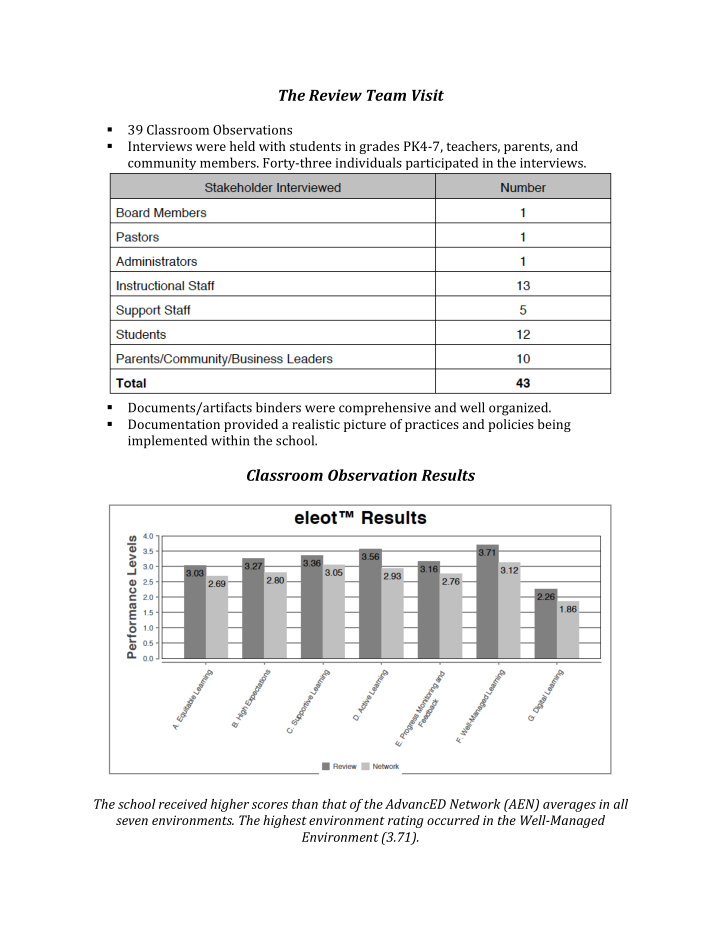



The ¡Review ¡Team ¡Visit ¡ ¡ � 39 ¡Classroom ¡Observations ¡ � Interviews ¡were ¡held ¡with ¡students ¡in ¡grades ¡PK4-‑7, ¡teachers, ¡parents, ¡and ¡ community ¡members. ¡Forty-‑three ¡individuals ¡participated ¡in ¡the ¡interviews. ¡ ¡ ¡ � Documents/artifacts ¡binders ¡were ¡comprehensive ¡and ¡well ¡organized. ¡ � Documentation ¡provided ¡a ¡realistic ¡picture ¡of ¡practices ¡and ¡policies ¡being ¡ implemented ¡within ¡the ¡school. ¡ ¡ Classroom ¡Observation ¡Results ¡ ¡ ¡ ¡ The ¡school ¡received ¡higher ¡scores ¡than ¡that ¡of ¡the ¡AdvancED ¡Network ¡(AEN) ¡averages ¡in ¡all ¡ seven ¡environments. ¡The ¡highest ¡environment ¡rating ¡occurred ¡in ¡the ¡Well-‑Managed ¡ Environment ¡(3.71). ¡
Classroom ¡Observation ¡Results ¡Continued ¡ ¡ Active ¡Learning: ¡ � Students ¡had ¡many ¡opportunities ¡to ¡participate ¡in ¡small ¡group ¡activities, ¡as ¡well ¡as ¡ to ¡engage ¡in ¡discussions ¡with ¡teachers. ¡ ¡ � Engagement ¡was ¡seen ¡at ¡all ¡grade ¡levels ¡and ¡subject ¡areas. ¡ ¡ � Students ¡used ¡the ¡Promethean ¡Boards, ¡computers, ¡and ¡manipulative ¡materials. ¡ ¡ � Students ¡responded ¡well ¡to ¡teacher ¡initiated ¡questions. ¡ ¡ � Application ¡of ¡knowledge ¡was ¡seen ¡throughout ¡all ¡observations. ¡ � Students ¡were ¡required ¡to ¡compare, ¡contrast, ¡and ¡classify ¡information ¡in ¡practical ¡ situations. ¡ ¡ Supportive ¡Learning: ¡ � Positive ¡learning ¡experiences ¡and ¡positive ¡attitudes ¡about ¡learning ¡were ¡"evident" ¡ to ¡"strongly ¡evident" ¡in ¡all ¡grade ¡levels ¡and ¡across ¡all ¡subject ¡areas. ¡ � Students ¡willingly ¡participated ¡in ¡activities ¡and ¡showed ¡excitement ¡when ¡asked ¡to ¡ work ¡at ¡the ¡Promethean ¡Boards, ¡answer ¡questions ¡or ¡read ¡aloud. ¡ ¡ � Students ¡were ¡willing ¡to ¡try ¡new ¡tasks ¡and ¡asked ¡questions. ¡ ¡ Other ¡Areas ¡of ¡Learning: ¡ � Students ¡know ¡and ¡strive ¡to ¡meet ¡the ¡high ¡expectations ¡established ¡in ¡the ¡ classrooms ¡as ¡indicated ¡by ¡ratings ¡being ¡"evident" ¡to ¡"very ¡evident." ¡ ¡ � Learning ¡activities ¡were ¡rigorous ¡and ¡challenging ¡at ¡all ¡grade ¡levels ¡and ¡across ¡all ¡ subject ¡areas. ¡ � The ¡school ¡is ¡focused ¡on ¡continuous ¡quality ¡improvement ¡in ¡all ¡areas ¡of ¡operation. ¡ ¡ � The ¡school ¡maintains ¡a ¡strong, ¡family-‑orientated, ¡Catholic ¡culture. ¡All ¡stakeholder ¡ groups ¡espoused ¡the ¡value ¡of ¡having ¡a ¡small ¡school ¡with ¡a ¡welcoming, ¡loving ¡ environment ¡that ¡maintains ¡high ¡expectations ¡for ¡instruction/learning. ¡ � The ¡use ¡of ¡differentiated ¡learning ¡opportunities ¡and ¡activities ¡was ¡stronger ¡at ¡the ¡ lower ¡grade ¡levels. ¡ � All ¡students ¡have ¡equal ¡access ¡to ¡classroom ¡discussions, ¡activities, ¡resources, ¡ technology, ¡and ¡support. ¡Teachers ¡called ¡on ¡students ¡randomly ¡ensuring ¡all ¡ students ¡had ¡their ¡turn ¡to ¡participate. ¡ � Rules ¡and ¡consequences ¡were ¡consistently ¡applied. ¡ ¡ Support ¡previous ¡improvements: ¡ � The ¡eleot ¡ratings ¡support ¡the ¡recent ¡decision ¡of ¡the ¡faculty ¡to ¡increase ¡daily ¡math ¡for ¡ grades ¡5-‑7 ¡by ¡15 ¡minutes ¡to ¡better ¡meet ¡the ¡needs ¡of ¡the ¡middle ¡school ¡students. ¡ ¡ � The ¡school-‑wide ¡use ¡of ¡the ¡Depth ¡of ¡Knowledge ¡questioning ¡techniques ¡and ¡the ¡ emphasis ¡on ¡Bloom's ¡Taxonomy ¡supports ¡the ¡number ¡of ¡activities ¡that ¡required ¡ application ¡of ¡higher ¡order ¡thinking ¡skills. ¡ ¡ � The ¡high ¡ratings ¡in ¡the ¡Well-‑Managed ¡Environment ¡and ¡in ¡the ¡consistent ¡use ¡of ¡ rules ¡and ¡consequences ¡attest ¡to ¡the ¡implementation ¡of ¡the ¡school's ¡PBIS ¡program. ¡ ¡ Ratings ¡-‑ ¡Projected ¡
Opportunities ¡for ¡improvement: ¡ ¡ 1. Math ¡instruction ¡improvement ¡recommendations: ¡ a. Use ¡of ¡rubrics/exemplars ¡ b. Use ¡of ¡additional/alternative ¡instruction ¡– ¡Differentiated ¡instruction ¡ c. Use ¡of ¡supplementary ¡materials ¡ d. Use ¡of ¡exemplars ¡ e. Implementation ¡of ¡question ¡techniques ¡using ¡higher ¡order ¡thinking ¡skills ¡ f. Use ¡of ¡additional ¡time ¡to ¡revise/improve ¡work ¡ 2. Forty ¡percent ¡of ¡the ¡upper ¡grade ¡levels ¡received ¡a ¡rating ¡of ¡"somewhat ¡evident" ¡on ¡ differentiated ¡learning ¡opportunities. ¡ ¡ 3. There ¡is ¡a ¡need ¡for ¡more ¡opportunity ¡to ¡learn ¡about ¡own ¡and/or ¡other's ¡ backgrounds/cultures/differences. ¡ 4. The ¡school ¡stated ¡in ¡the ¡Self-‑Assessment ¡that ¡there ¡is ¡a ¡need ¡for ¡additional ¡training ¡ to ¡fully ¡implement ¡the ¡tools ¡and ¡programs ¡in ¡technology ¡that ¡the ¡school ¡recently ¡ purchased. ¡ 5. Develop ¡a ¡formal ¡mentoring, ¡coaching, ¡and ¡induction ¡program ¡to ¡accommodate ¡ changes ¡in ¡your ¡teaching ¡staff. ¡ ¡ a. “A ¡formalized ¡mentoring, ¡coaching, ¡and ¡induction ¡program ¡allows ¡for ¡the ¡full ¡ integration ¡of ¡all ¡employees ¡whether ¡they ¡be ¡new ¡to ¡the ¡school ¡or ¡to ¡the ¡ grade ¡level/subject ¡area.” ¡ ¡ b. “However, ¡it ¡is ¡not ¡only ¡new ¡personnel ¡who ¡need ¡to ¡feel ¡supported ¡and ¡to ¡ have ¡a ¡“go-‑to ¡person” ¡for ¡advice ¡on ¡teaching ¡techniques/strategies. ¡Veteran ¡ teachers ¡also ¡need ¡reassurance ¡and ¡support. ¡Peer-‑to-‑peer ¡coaching ¡allows ¡ teachers ¡to ¡share ¡among ¡themselves ¡their ¡teaching ¡strategies ¡in ¡order ¡to ¡ perfect ¡best ¡practices. ¡Mentoring ¡and ¡developing ¡peer ¡relationships ¡and ¡ cross ¡grade ¡level ¡partnerships ¡are ¡ways ¡of ¡supporting ¡the ¡individuals ¡and ¡ groups ¡implementing ¡improvement ¡initiatives. ¡ 6. Formalize ¡professional ¡development ¡to ¡coincide ¡with ¡data ¡from ¡formal ¡and ¡informal ¡ teacher ¡observations ¡and ¡current ¡educational ¡research. ¡-‑ ¡more ¡professional ¡ development ¡is ¡needed ¡as ¡a ¡whole ¡school ¡on ¡effective ¡use ¡of ¡present ¡technology, ¡ using ¡standardized ¡testing ¡data ¡to ¡determine ¡gaps ¡within ¡the ¡curriculum, ¡and ¡ identifying ¡techniques ¡to ¡assist ¡with ¡student ¡needs. ¡ 7. Train ¡professional ¡and ¡support ¡staff ¡on ¡the ¡interpretation ¡and ¡use ¡of ¡test ¡data. ¡-‑ ¡ With ¡the ¡abundance ¡of ¡testing ¡data ¡available ¡to ¡the ¡instructional ¡staff, ¡they ¡need ¡to ¡ understand ¡the ¡relationship ¡among ¡all ¡this ¡information ¡and ¡to ¡know ¡how ¡to ¡apply ¡ the ¡information ¡to ¡best ¡meet ¡the ¡needs ¡of ¡the ¡student ¡and ¡to ¡track ¡instructional ¡ improvements. ¡
Recommend
More recommend